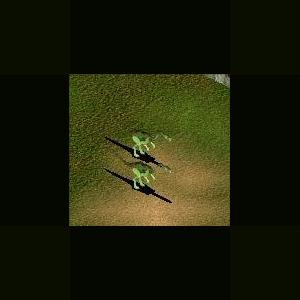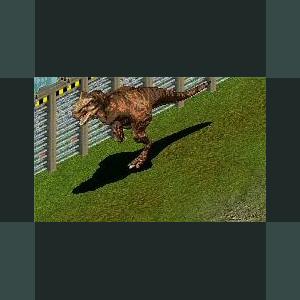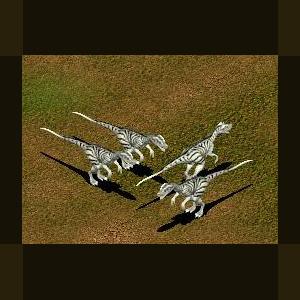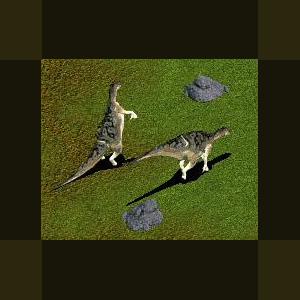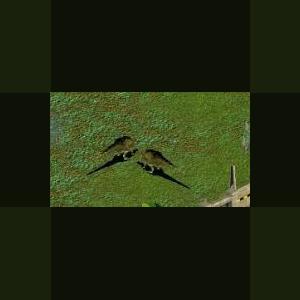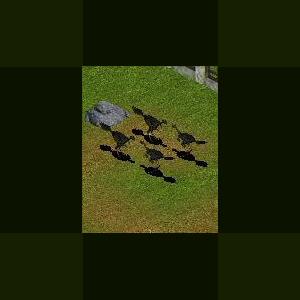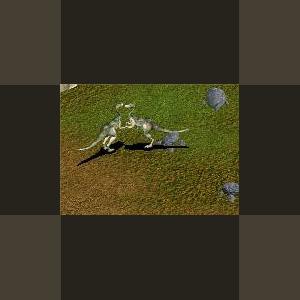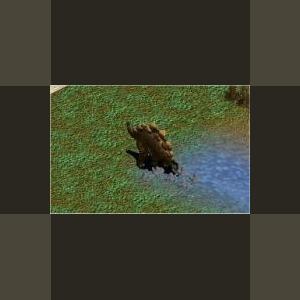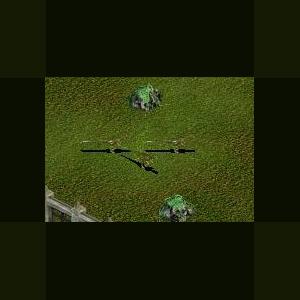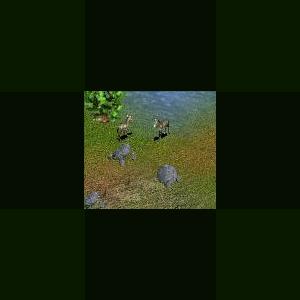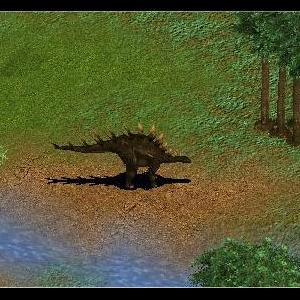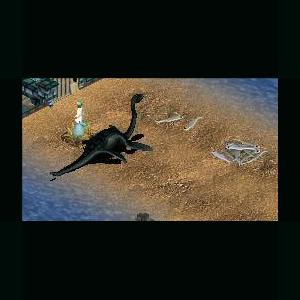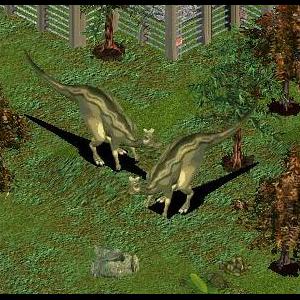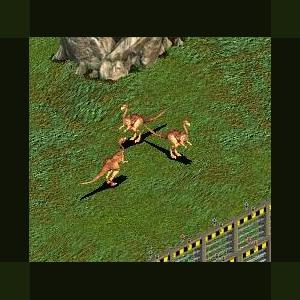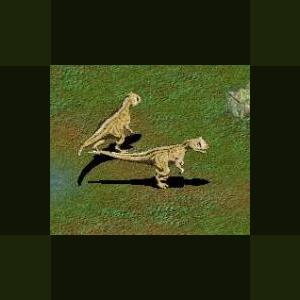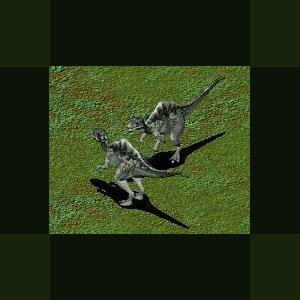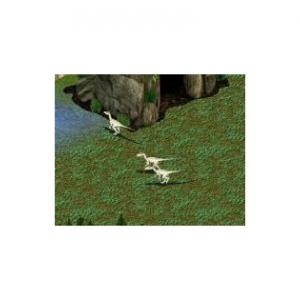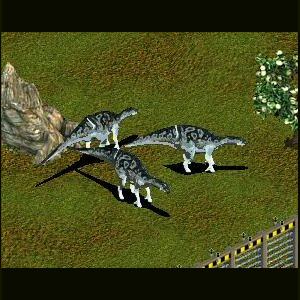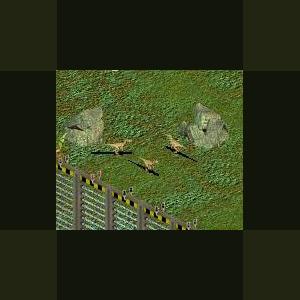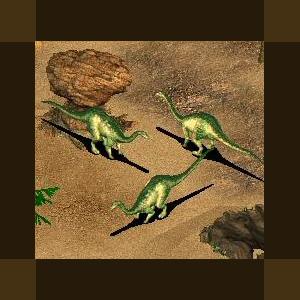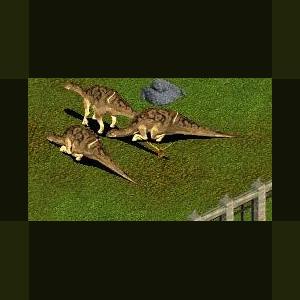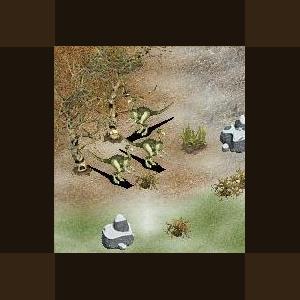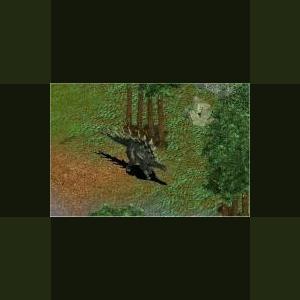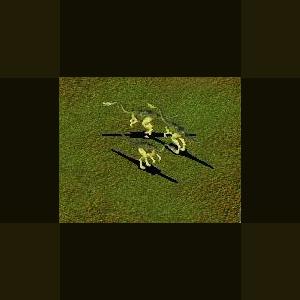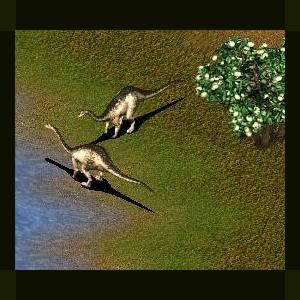Dinosaurs
Creatures from another age
241 files
-
Gojirasaurus by Moondawg
By Guest
Gojirasaurus
Gojirasaurus is a genus of dinosaur named after Gojira (the Japanese name for Godzilla). It was discovered in Revuelto Creek, Quay County, New Mexico. The type specimen is a partial skeleton of a semi-adult, about 5.5 m (18 ft) long, which can be extrapolated to a weight of approximately 150–200 kg (330–440 lb). An adult would have been around 6.5 m (21 ft) long. It lived during the Norian age of the Late Triassic Period, between 220 and 209 million years ago. Gojirasaurus was a member of the Coelophysoidea, which were all small, early theropods. Gojirasaurus was perhaps the largest meat-eater know from the Triassic Period and enormous for its time. A serrated tooth, four ribs, four backbones, and a few other bones have been uncovered.
167 downloads
0 comments
Updated
-
Gorgosaurus by Moondawg
By Guest
Like most known tyrannosaurids, Gorgosaurus was a multi-ton bipedal predator equipped with dozens of large, sharp teeth; it also bore tiny two-fingered forelimbs typical of its close relatives. Although relatively large for a theropod, Gorgosaurus was much smaller than its more famous relative Tyrannosaurus.
Gorgosaurus (pronounced GOR-go-SAWR-us; meaning "fierce lizard") is a genus of tyrannosaurid theropod dinosaur that lived in western North America during the Late Cretaceous Period, between about 77 and 74 million years ago. Fossil remains have been found in the Canadian province of Alberta and possibly the U.S. state of Montana. Paleontologists recognize only the type species, G. libratus, although other species have been erroneously referred to the genus.
Like most known tyrannosaurids, Gorgosaurus was a bipedal predator weighing more than a metric ton as an adult; dozens of large, sharp teeth lined its jaws, while its two-fingered forelimbs were comparatively small. Gorgosaurus was most closely related to Albertosaurus, and more distantly related to the larger Tyrannosaurus. Gorgosaurus and Albertosaurus are extremely similar, distinguished mainly by subtle differences in the teeth and skull bones. Some experts consider G. libratus to be a species of Albertosaurus; this would make Gorgosaurus a junior synonym of that genus.
Gorgosaurus lived in a lush floodplain environment along the edge of an inland sea. An apex predator, it was at the top of the food chain, preying upon abundant ceratopsids and hadrosaurs. In some areas, Gorgosaurus coexisted with another tyrannosaurid, Daspletosaurus. Though these animals were roughly the same size, there is some evidence of niche differentiation between the two. Gorgosaurus is the best-represented tyrannosaurid in the fossil record, known from dozens of specimens. These plentiful remains have allowed scientists to investigate its ontogeny, life history and other aspects of its biology.
290 downloads
0 comments
Updated
-
Guaibasaurus by Moondawg
By Guest
Guaibasaurus (meaning "Guaiba Lizard") was a basal Saurischian dinosaur which lived during the Triassic.
Its fossils were found in state of Rio Grande do Sul, Brazil. Like Herrerasaurus, this dinosaur had three full fingers, and two vestigial ones on each hand.
The type species, G. candelariai, was described by Jose Bonaparte and J. Ferigolo in 1998
146 downloads
0 comments
Updated
-
Gyposaurus by Moondawg
By Guest
Gryposaurus is similar to Kritosaurus, and for many years was regarded as the same genus. It is known from numerous skulls, some skeletons, and even some skin impressions that show it to have had pyramidal scales pointing out along the midline of the back. It is most easily distinguished from other duckbills by its narrow arching nasal hump, sometimes described as similar to a "Roman nose," and which may have been used for species or sexual identification, and/or combat with individuals of the same species. A large bipedal/quadrupedal herbivore around 9 meters long (30 ft), it may have preferred river settings.
Gryposaurus was a hadrosaurid of typical size and shape; one of the best specimens, the nearly complete type specimen of G. incurvimanus now on display at the Royal Tyrrell Museum of Palaeontology, came from an animal about 8.2 meters long (27 feet). This specimen also has the best example of skin impressions for Gryposaurus, showing this dinosaur to have had several different types of scalation: pyramidal, ridged, limpet-shaped scutes upwards of 3.8 centimeters long (1.5 inches) on the flank and tail; uniform polygonal scales on the neck and sides of the body; and pyramidal structures, flattened side-to-side, with fluted sides, longer than tall and found along the top of the back in a single midline row.
The four named species of Gryposaurus differ in details of the skull and lower jaw.The prominent nasal arch found in this genus is formed from the paired nasal bones. In profile view, they rise into a rounded hump in front of the eyes, reaching a height as tall as the highest point of the back of the skull. The skeleton is known in great detail, making it a useful point of reference for other duckbill skeletons.
216 downloads
0 comments
Updated
-
Hadrosaurus by Moondawg
By Guest
Hadrosaurus (hadros + sauros = sturdy lizard) is a dubious genus of hadrosaurid dinosaur.
In 1858, a skeleton of a dinosaur from this genus was the first full dinosaur skeleton found in North America and, in 1868, it became the first ever mounted dinosaur skeleton. Hadrosaurus foulkii is the only species in this genus and has been the official state dinosaur of New Jersey since 1991.
Hadrosaurus lived near what is now the coast of New Jersey, U.S.A., in the late Cretaceous Period - around 80 million years ago. It was likely bipedal for the purposes of running, but could use its forelegs to support itself while grazing - like all hadrosaurids, Hadrosaurus was herbivorous. Its teeth suggest it ate twigs and leaves
Hadrosaurus lived near what is now the coast of New Jersey, U.S.A., in the late Cretaceous Period - around 80 million years ago. It was likely bipedal for the purposes of running, but could use its forelegs to support itself while grazing - like all hadrosaurids, Hadrosaurus was herbivorous. Its teeth suggest it ate twigs and leaves.
In 1838, William Estaugh Hopkins was digging in a marl pit (on a small tributary of the Cooper River in Haddonfield, New Jersey) when he uncovered large bones, putting them on display at his home, also in Haddonfield. In 1858 these bones sparked the interest of a visitor, William Parker Foulke. The skeleton was dug out from the marl pit in 1858 by Foulke. In the same year, the species was named by paleontologist Joseph Leidy from an almost complete set of limbs, along with a pelvis, several part of the feet, twenty-eight vertebrae (including eighteen from the tail), eight teeth and two small parts of the jaw. Leidy recognized that these bones were from a dinosaur by their similarity to those of Iguanodon, discovered in England some decades before, but the skeleton of Hadrosaurus was far more complete. Leidy's monograph Cretaceous Reptiles of the United States, describing Hadrosaurus more completely and with illustrations, was written in 1860 but the American Civil War delayed its publication until 1865. Leidy reconstructed Hadrosaurus as a biped, in contrast to the view at the time that such dinosaurs were quadrupedal. The entire skeleton was completely assembled in 1868 by a team including English sculptor and naturalist Benjamin Waterhouse Hawkins and was put on display at Philadelphia Academy of Natural Sciences, where it remains available for public viewing.
246 downloads
0 comments
Updated
-
Hagryphus by Moondawg
By Guest
Hagryphus
Hagryphus ("Ha's griffin", from Egyptian Ha, name of a god of the western desert and Greek gryphus meaning 'griffin' (a mythological bird-like creature); Zanno and Sampson, 2005) is an oviraptorosaurian theropod dinosaur from the Upper Cretaceous Period of what is now Utah.
To date, only a single species is known, H. giganteus. The holotype was discovered in the Kaiparowits Formation (Late Campanian) in the Grand Staircase-Escalante National Monument of southern Utah. Radiometric dating indicates that the beds where the specimen was found date to between 76 and 75 million years ago. Designated UMNH VP 12765, the type specimen resides in the collections of the Utah Museum of Natural History in Salt Lake City. It consists of an incomplete but articulated left manus and the distal portion of the left radius. Both the semilunate and radiale are preserved.
Other known species of North American oviraptorosaurs include Elmisaurus rarus, Microvenator celer, and Chirostenotes pergracilis. This group of dinosaurs is better known from the Cretaceous of Asia, where forms such as Khaan mckennai, Conchoraptor gracilis and Oviraptor philoceratops have been discovered.
Oviraptorosaurs are characterized by a shortened snout, massive endentulous jaws and extensively pneumatized skulls, often sporting elaborate crests, the function of which remains unknown. The toothless jaws may indicate a diet of eggs but these theropods likely fed on small vertebrates as well. Evidence suggests that they were feathered and some paleontologists consider them to be true birds (see the main article Oviraptorosauria for further information).
As the species name indicates, Hagryphus giganteus was a particularly large oviraptorosaur, estimated to have been approximately 3 meters (10 ft) long, which makes it one of the largest members of the clade Oviraptorosauria (Barsbold, 1976). H. giganteus is estimated to be 30-40% larger than the next largest known North American oviraptorosaur, Chirostenotes.
170 downloads
0 comments
Updated
-
Harpymimus by Moondawg
By Guest
Harpymimus was a basal ornithomimosaur from the Early Cretaceous Period of what is now Mongolia. Unlike later, more derived ornithomimosaurs,
The holotype specimen (IGM 100/29, Mongolian Academy of Sciences, Ulan Bator, Mongolia) consists of an almost complete skeleton, lacking portions of the pectoral girdle, pelvic girles, and hindlimbs. It was recovered at Dundgovi Aimag (Eastern Gobi Province), from an exposure of the Shinekhudug Formation (Shinekhudukskaya Svita; Hauterivian to Barremian). The etymology of Harpymimus involves a reference to the fearsome Harpy of Greek mythology (Greek harpyiai = "Harpies" + Greek mimos = "mimic"). Only a single species is known for this genus, H. oklandnikovi. Other dinosaurs collected from the Shinekhudug Formation at Dundgov include the ceratopsian Psittacosaurus mongoliensis and the ornithopod Altirhinus kurzanovi.
Inspired by the Zoo Tek Brains Trust
134 downloads
0 comments
Updated
-
Hesperosaurus by Ghirin
By Guest
Hesperosaurus by Ghirin
Hesperosaurus ("Western Lizard") is the oldest known genus of stegosaur in North America.
Reference:
The Illustrated Encyclopedia of Dinosaurs by Dougal Dixon. 2006
189 downloads
0 comments
Updated
-
Heterodontosaurus by Moondawg
By Guest
Heterodontosaurus (meaning "Different Toothed Lizard") was a small herbivorous dinosaur with sharp canine teeth which lived in the Early Jurassic of South Africa.
It was similar to a Hypsilophodont in shape, and ate plants, despite its razor-sharp canines.
Heterodontosaurus is currently known from specimens of the SAFM (South African Museum) from South Africa. There are two known morphologies of this genus, the second of which is thought by some to represent a different species. The type species, H. tucki, is from the Upper Elliot Formation of Hettangian (199-196 Million Years Ago) age. It is probably a senior objective synonym of Abrictosaurus, as has been suggested in the past.
Heterodontosaurus was a small, fleetfooted ornithischian that reached a maximum size of about 3 feet. It had a long, narrow pelvis and a pubis which resembled those possessed by more advanced ornithischians.
More unusual was that the hand of Heterodontosaurus had five fingers, two of which seem to be opposable. This configuration allowed Heterodontosaurus to grasp and manipulate food. The bone in the foot and ankle were fused in a manner reminiscent of those in birds.
Another interesting feature is the specialization of teeth which gave rise to the animal's name. Most dinosaurs (and indeed most reptiles) have a single type of tooth in their jaws, while Heterodontosaurus had three. At the front of the jaw beside the beak were small teeth likely used for chopping off leaves and stems.
Next in the jaw was a large pair of tusks whose purpose is unknown, but it is speculated that they were used as sexual displays. In that scenario, the tusks could have been used as weapons by rival males in disputes over mates and territories. The final type of teeth were tall and squared off. This type of teeth was well adapted for chewing. Fleshy cheeks helped keep the food in the mouth while chewing occurred. Chewing is relatively common in dinosaurs, but uncommon for other groups of reptiles.
This bizarre suite of teeth has led to debate over what heterodontosaurs ate. Some scientists think heterodontosaurs were omnivores who used their differently-shaped teeth to eat both plants and small animals
163 downloads
0 comments
Updated
-
Hipparion by Moondawg
By Guest
Hipparion (Greek, "pony") is an extinct genus of horse.
It resembled the modern horse, but still had vestigal outer toes (in addition to its hoof). These did not touch the ground. Hipparion was about 1,40 m (4 ft 8 in) tall at the shoulder.
Must have Dino Digs and/or Complete Collection in order for food to show up.
246 downloads
0 comments
Updated
-
Huayangosaurus by Ghirin
By Guest
Huayangosaurus by Ghirin
The primitive stegosaur Huayangosaurus ("Lizard from Huayang") lived in China during the middle Jurassic period.
Reference:
www.wikipedia.org
*Inspired by the Zoo Tycoon Braind Trust at the Zoo Tek Forums*
Created by Ghirin 2007
189 downloads
0 comments
Updated
-
Hydrotherosaurus by Moondawg
By Guest
Hydrotherosaurus (meaning "water beast lizard") is an extinct genus of elasmosaurid plesiosaur from the Upper Cretaceous (Maastrichtian) of Fresno County, California, measuring up to 13 m in length.
288 downloads
Updated
-
Hypacrosaurus by Moondawg
By Guest
Hypacrosaurus
Hypacrosaurus (meaning "near the highest lizard", because it was almost but not quite as large as Tyrannosaurus) was a genus of duckbill dinosaur similar in appearance to Corythosaurus. Like Corythosaurus, it had a tall, hollow rounded crest, although not as large and straight. It is known from the remains of two species that lived about 76 to 68 million years ago, in the Late Cretaceous of Alberta, Canada, and Montana, USA, and is the latest hollow-crested duckbill known from good remains in North America. It was an obscure genus until the description of nests, eggs, and hatchlings belonging to H. stebingeri in the 1990s.
Hypacrosaurus is most easily distinguished from other hollow-crested duckbills (lambeosaurines) by its tall neural spines and the form of its crest. The neural spines, which project from the top of the vertebrae, are 5 to 7 times the height of the body of their respective vertebrae in the back, which would have given it a tall back in profile. The skull's hollow crest is like that of Corythosaurus, but is more pointed along its top, not as tall, wider side to side, and has a small bony point at the rear. Unlike other lambeosaurines, the passages for the airways do not form an S-curve in the crest (at least not in H. altispinus). The animal is estimated to have been around 9.1 meters long (30 feet), and to have weighed up to 4.0 tonnes (4.4 tons). As with most duckbills, its skeleton is otherwise not particularly remarkable, although some pelvic details are distinctive. Like other duckbills, it was a bipedal/quadrupedal herbivore. The two known species, H. altispinus and H. stebingeri, are not differentiated in the typical method, of unique characteristics, as H. stebingeri was described as transitional between the earlier Lambeosaurus and later Hypacrosaurus. Photographs of an adult H. stebingeri skull show an animal that looks very similar to H. altispinus.
Hypacrosaurus was a lambeosaurinae hadrosaurid, and has been recognized as such since the description of its skull. Within the Lambeosaurinae, it is closest to Lambeosaurus and Corythosaurus, with Jack Horner and Phil Currie (1994) suggesting that H. stebingeri is transitional between Lambeosaurus and H. altispinus, and Michael K. Brett-Surman (1989) suggesting that Hypacrosaurus and Corythosaurus are the same genus. These genera, particularly Corythosaurus and Hypacrosaurus, are regarded as the "helmeted" or "hooded" branch of the lambeosaurines, and the clade they form is sometimes informally designated Lambeosaurini. Although Suzuki et al.'s 2004 redescription of Nipponosaurus found a close relationship between Nipponosaurus and Hypacrosaurus stebingeri, indicating that Hypacrosaurus may be paraphyletic, this was rejected in a later, more comprehensive reanalysis of lambeosaurines, which found the two species of Hypacrosaurus to form a clade without Nipponosaurus, with Corythosaurus and Olorotitan being the closest relatives.
The type remains of Hypacrosaurus remains were collected in 1910 by Barnum Brown for the American Museum of Natural History. The remains, a partial postcranial skeleton consisting of several vertebrae and a partial pelvis (AMNH 5204), came from along the Red Deer River near Tolman Ferry, Alberta, Canada, from rocks of what is now known as the Horseshoe Canyon Formation (early Maastrichtian, Upper Cretaceous). Brown described these remains, in combination with other postcranial bones, in 1913 as a new genus that he considered to be like Saurolophus. No skull was known at this time, but two skulls were soon discovered and described.
During this period, the remains of small hollow-crested duckbills were described as their own genera and species. The first of these that figure into the history of Hypacrosaurus was Cheneosaurus tolmanensis, based on a skull and assorted limb bones, vertebrae, and pelvic bones from the Horseshoe Canyon Formation. Not long after, Richard Swann Lull and Nelda Wright identified an American Museum of Natural History skeleton (AMNH 5461) from the Two Medicine Formation of Montana as a specimen of Procheneosaurus. These and other taxa were accepted as valid genera until the 1970s, when Peter Dodson showed that it was more likely that the "cheneosaurs" were the juveniles of other established lambeosaurines. Although he was mostly concerned with the earlier, Dinosaur Park Formation genera Corythosaurus and Lambeosaurus, he suggested that Cheneosaurus would turn out to be composed of juvenile individuals of the contemporaneous Hypacrosaurus altispinus. This idea has become accepted, although not formally tested. The Two Medicine Procheneosaurus, meanwhile, was not quite like the other Procheneosaurus specimens studied by Dodson, and for good reason: it was much more like a species that would not be named until 1994, H. stebingeri.
H. altispinus shared the Horseshoe Canyon Formation with fellow hadrosaurids Edmontosaurus and Saurolophus, hypsilophodont Parksosaurus, ankylosaurid Euoplocephalus, nodosaurid Edmontonia, horned dinosaurs Montanoceratops, Anchiceratops, Arrhinoceratops, and Pachyrhinosaurus, pachycephalosaurid Stegoceras, ostrich-mimics Ornithomimus and Struthiomimus, a variety of poorly-known small theropods including troodontids and dromaeosaurids, and the tyrannosaurs Albertosaurus and Daspletosaurus. The dinosaurs from this formation are sometimes known as Edmontonian, after a land mammal age, and are distinct from those in the formations above and below. The Horseshoe Canyon Formation is interpreted as having a significant marine influence, due to an encroaching Western Interior Seaway, the shallow sea that covered the midsection of North America through much of the Cretaceous. H. altispinus may have preferred to stay more landward.
The slightly older Two Medicine Formation, home to H. stebingeri, was also populated by another well-known nesting hadrosaur, Maiasaura, as well as the troodontid Troodon, which is also known from nesting traces. The tyrannosaurid Daspletosaurus, caenagnathid Chirostenotes, dromaeosaurids Bambiraptor and Saurornitholestes, armored dinosaurs Edmontonia and Euoplocephalus, hypsilophodont Orodromeus, hadrosaur Prosaurolophus, and horned dinosaurs Achelousaurus, Brachyceratops, Einiosaurus, and Styracosaurus ovatus were also present. This formation was more distant from the Western Interior Seaway, higher and drier, with a more terrestrial influence.
As a hadrosaurid, Hypacrosaurus would have been a bipedal/quadrupedal herbivore, eating a variety of plants. Its skull permitted a grinding motion analogous to chewing, and its teeth were continually replacing and packed into dental batteries that contained hundreds of teeth, only a relative handful of which were in use at any time. Plant material would have been cropped by its broad beak, and held in the jaws by a cheek-like organ. Its feeding range would have extended from the ground to ~4 m (13 ft) above.
H. stebingeri laid roughly spherical eggs of 20 by 18.5 cm (7.9 by 7.3 inches), with embryos 60 cm long (23.6 in). Hatchlings were around 1.7 m long (5.6 ft). Young and embryonic individuals had deep skulls with only slight expansion in the bones that would one day form the crest. Growth was faster than that of an alligator and comparable to ratite growth, for several years, based on the amount of bone growth seen between lines of arrested growth (analogous to growth rings in trees). Research by Lisa Cooper and colleagues on H. stebingeri indicates that this animal may have reached reproductive maturity at the age of 2 to 3 years, and reached full size at about 10 to 12 years old. The circumference of the thigh bone at postulated reproductive maturity was about 40% that of its circumference at full size. The postulated growth rate of H. stebingeri outpaces those of tyrannosaurids (predators of hypacrosaurs) such as Albertosaurus and Tyrannosaurus; rapidly-growing hypacrosaurs would have had a better chance to reach a size large enough to be of defensive value, and beginning reproduction at an early age would also have been advantageous to a prey animal.
The hollow crest of Hypacrosaurus most likely had social functions, such as a visual signal allowing individuals to identify sex or species, and providing a resonating chamber for making noises. The crest and its associated nasal passages have also figured in the debate about dinosaur endothermy, specifically in discussions about nasal turbinates.
Turbinates are thin bones or cartilages that come in two types, with two functions. Nasal olfactory turbinates are found in all living tetrapods and function in smell. Respiratory turbinates function to prevent water loss through evaporation and are found only in birds and mammals, modern endotherms (warm-blooded animals) who could lose a great deal of water while breathing because they breathe more often than comparably-sized ectotherms (cold-blooded animals) to support their higher metabolism. Ruben and others in 1996 concluded that respiratory turbinates were probably not present in Nanotyrannus, Ornithomimus or Hypacrosaurus based on CT scanning, thus there was no evidence that those animals were warm-blooded.
203 downloads
0 comments
Updated
-
Hypsilophodon by Moondawg
By Guest
Hypsilophodon
Hypsilophodon ( meaning 'high-crested tooth') is an ornithopod dinosaur genus from the Early Cretaceous Period of Europe. It was a small bipedal animal with an herbivorous or possibly omnivorous diet. Abundant fossil remains found in England indicate that Hypsilophodon reached about 2 meters (6.5 feet) in length.
The first remains of Hypsilophodon were recovered in the early days of paleontology in 1849. However, at the time, the bones were thought to belong to a young Iguanodon. It was not until 1870 that paleontologist T. H. Huxley was able to publish a full description of Hypsilophodon as we know it today. He had been provided with a number of skeletons by the Reverend William Fox, after whom the first species of Hypsilophodon was named.
Early paleontologists modeled the body of this small, bipedal, herbivorous dinosaur in various ways. In 1882 some paleontologists suggested that, like a modern tree-kangaroo, Hypsilophodon was able to climb trees in order to seek shelter. This was the accepted view for almost a century. However, Peter M. Galton finally performed more accurate analysis of the musculo-skeletal structure in 1974 and convinced most paleontologists that Hypsilophodon remained firmly on the ground.
Since then, three near-complete and over twenty minor finds have been made, especially on the Isle of Wight, off the south coast of England. Other finds have been made in southern England and Portugal.
Another misconception concerning the anatomy of Hypsilophodon was that it was armoured. The putative armour, consisting of thin mineralized plates from the torso, instead appear to be examples of intercostal plates associated with the rib cage. Such plates are better known from Talenkauen and Thescelosaurus, and were probably cartilaginous in origin.
There is only one known species of Hypsilophodon, Huxley's original H. foxii. Galton and Jensen named another species in 1979, H. wielandi, which is based on a thigh bone from South Dakota, USA, but it is now regarded as an indeterminate basal ornithopod.
Hypsilophodon was a relatively small dinosaur. While not quite so small as, for example, Compsognathus, Hypsilophodon was only around 2.3 metres in length. It would have reached approximately waist-height on a modern man and would have weighed about the same, at 50 to 70 kilograms (110 to 150 lb).
Like most small dinosaurs, Hypsilophodon was bipedal and ran on two legs. Its entire body was built for running; a light-weight, minimized skeleton, low, aerodynamic posture, long legs and stiff tail for balance all would have allowed it to travel remarkably fast for its size.
Due to its small size, Hypsilophodon fed on low-growing vegetation, most likely preferring young shoots and roots in the manner of modern deer. The structure of its skull, with the teeth set far back into the jaw, strongly suggests that it had cheeks, an advanced feature that would have facilitated the chewing of food. There were twenty-eight to thirty ridged teeth in the animal's jaw which, due to their alternate arrangement, appear to have been self-sharpening. As in almost all dinosaurs and certainly all the ornithischians, the teeth were continuously replaced.
The level of parental care in this dinosaur has not been defined, although a neatly-arranged nest has been found, suggesting that some care was taken before hatching. Fossils of large groups have been found, so it is likely that the animals moved in herds. For these reasons, the hypsilophodonts, particularly Hypsilophodon, have often been referred to as the "deer of the Mesozoic".
Despite living in the last of the periods in which dinosaurs walked the earth, the Cretaceous, Hypsilophodon had a number of primitive features. For example, there were five digits on each 'hand' and four on each foot. Most dinosaurs had lost these redundant features by the Cretaceous period. Also, although it had a beak like most ornithischians, Hypsilophodon still had pointed triangular teeth in the front of the jaw. Most herbivorous dinosaurs had, by this stage, become sufficiently specialized that the front teeth had been altogether lost (although there is some debate as to whether these teeth may have had a specialized function in Hypsilophodon).
The group Hypsilophodontidae remained remarkably static from the late Jurassic to the end of the Cretaceous. It is possible that this was because the animals were almost perfectly adapted to their lifestyle, therefore selective pressure, it is assumed, was low.
http://en.wikipedia.org/wiki/Hypsilophodon
189 downloads
0 comments
Updated
-
Indosuchus by Moondawg
By Guest
Indosuchus raptorius was an abelisaurid dinosaur from the Late Cretaceous Period (65 to 70 million years ago - the Maastrichtian era),
A primitive theropod related to Abelisaurus. Like most theropods, Indosuchus was a bipedal carnivore. It was possibly 20 feet (6 meters) long, and had a crested skull, flattened on the top.
Because only some skull elements have been found, Indosuchus placement has been somewhat erratic. Although it's now somewhat firmly placed within the Abelisauridae, it has been also grouped with allosaurs and tyrannosaurs. The discovery of other abelisaurid species like Carnotaurus sastrei has helped clarify its position.
190 downloads
0 comments
Updated
-
Irritator by Moondawg
By Guest
Irritator is a genus of spinosaurid dinosaur that lived in the early Cretaceous Period (Albian stage), around 110 million years ago.
Current estimations indicate a length of 8 meters (26 feet) and a height of 3 meters (9 feet). It was found in Brazil. Irritator was a theropod with an unusually shaped crest at the rear of its head, and probably ate fish.
So far the only fossil that has been found was an 80 centimeter long fossil skull in the Romualdo Member, a layer member of the Brazilian Santana formation. This skull strongly resembles the skulls of Suchomimus and Spinosaurus. The genus is often regarded today as identical (synonymous) with Angaturama, which lived in the same time and the same place as Irritator.
Irritator was first scientifically described in 1996 by paleontologists Martill, Cruikshank, Frey, Small and Clarke. Its only known fossil, an 80cm skull discovered in eastern Brazil, was badly obscured by plaster which was added by the commercial fossil-collecting amateurs who discovered it, and illegally sold it, since the trade of fossils is prohibited by law in Brazil, in hopes of making the fossil look more complete and valuable. It required a great deal of work to reconstruct the original features — hence the name.
It is probably synonymous with Angaturama limai, another spinosaurid from the same time and place, whose remains curiously seem to complete Irritator's skull, meaning that they could belong to the same specimen.
Material of I. challengeri, not counting that of A. limai, hails from the Romualdo Member of the Santana Formation in Brazil. The holotype is SMNS 58022, from the Stuttgart State Museum of the Natural Sciences, and it consists of an incomplete skull, lacking the anterior (front) portion.
The skull was recovered nearly complete and is considered the most complete head find of a Spinosaurid. It is characterized particularly by its unusual length and curved lip region, which is strongly compressed laterally. The overall length of the complete head is estimated at approximately 84 centimeters. It possesses a clear Sagittal crest; such a comb is found also with some other dinosaurs. The teeth exhibit a single embedding of the strongly extended and straight teeth with conical tooth crowns, which indicates a continual tooth change, as new teeth were pushed up between the old ones. The teeth exhibit lengths from 6 to approximately 40 millimeters.
In the year 2004 parts of a spinal column were discovered in the Santana Formation. These have been assigned, due to their structure, to the Spinosauridae. With very high probability these fossils belong to Irritator, since this is the so far the only so far well-known Spinosaurid of the formation.
Sorry I couldn't make the sail smaller so i left it as is :D
303 downloads
0 comments
Updated
-
Ivory Velociraptor by Ghirin
By Guest
The ivory velociraptor is a leucistic version of the velociraptor. While leucistic animals are light-colored, often white, they are not albinos. Albinism is defined as a defect in the production of the pigment melanin. Albino mammals usually have white fur because they only use melanin as a pigment. Other animals such as reptiles and amphibians have additional sources of pigmentation such as carotenoids (reds, oranges, yellows) and structures that reflect light (iridophores), producing greens and blues; thus, albino reptiles are often brightly colored with reds and yellows.
In extant reptiles and amphibians, there is an absence of cells that produce both melanin and carotenoids, and only a few iridophores are present. The result is white skin. Unlike albinism, color cannot be restored by the transplantation of normal chromoblastic cells and thus seems to be related to a defect in the skin itself. This condition appears to be limited to the skin because leucistic animals often have pigmented eyes, although the irises may be blue instead of the normal brown or black.
It is very likely that leucistic individuals occurred among dinosaurs, just as they do among modern animals; however, such individuals would have a major disadvantage compared to their normally colored fellows because they would stand out and be more likely to fall to predators. Just like leucistic animals today, the ivory velociraptor would have a higher survival rate in captivity than in the wild.
References:
Designer Reptiles and Amphibians. R.D. Bartlett and Patricia Bartlett, 2001.
Reptile and Amphibian Variants: Colors, Patterns, and Scales. H. Bernard Bechtel, 1995.
The Corn Snake Manual. Bill Love and Kathy Love, 2000.
Sites of Interest:
http://www.caudata.org/axolotl/genetics.htm
http://jeb.biologists.org/cgi/content/full/204/12/12/e
http://www.vmsherp.com/LCChromatophores.htm
http://www.herpbooks.com/care2/phen.html
http://www.cornsnakemorphs.com/genetics.html
Created by Ghirin 2003
176 downloads
0 comments
Updated
-
Jinzhousaurus by Moondawg
By Guest
Jinzhousaurus
Jinzhousaurus is a genus of hadrosauroid dinosaur. Its fossils, consisting of a nearly complete skeleton, were found in the Dawangzhangzi Beds of the Yixian Formation in Liaoning, China (dating to 122 million years ago, during the early Aptian stage of the early Cretaceous Period).The type (and currently only known) species is Jinzhousaurus yangi. It was first described by Wang Xiao-lin and Xu Xing in 2001.
192 downloads
0 comments
Updated
-
Juravenator by Moondawg
By Guest
Juravenator is a genus of small (2.5 feet long) coelurosaurian dinosaur, which lived in the area which would someday become the Jura mountains of Germany, 150 million years ago.
Juravenator was originally published as a member of the family Compsognathidae, making it a close relative of Sinosauropteryx and Sinocalliopteryx, for which there is fossil evidence of a downy, feather-like covering, yet a patch of fossilized Juravenator skin shows only normal dinosaur scales, with no sign of feathers at all. While it may simply have never had feathers, paleontologist Mark Norell suggest that the presence of scales on the Juravenator tail could mean a number of things:
Juravenator could have lost its feathers secondarily on at least some parts of its body, like some modern, partially featherless birds.
Feathers could have evolved more than once in different types of dinosaur.
Since the only known Juravenator skeleton is juvenile, it could be that this species only grew a significant covering of feathers as they aged, or lost feathers seasonally.
The feathers might simply have not been preserved in this specimen. "Feathers are really just difficult things to preserve," Norell says, though Luis Chiappe, director of the Dinosaur Institute at the Natural History Museum of Los Angeles County points out that the fossil skin does not show the follicles normally associated with dinosaur skin that has lost its feathers.
Additionally, subsequent studies have found problems with the initial study that placed Juravenator among the compsognathids. Rather than grouping it with Sinosauropteryx and other compsognathids, Butler et al. found that it was not a compsognathid, but rather a basal member of the group Maniraptora. Studies conflict on whether or not compsognathids belong to this later group or are more primitive, though all other maniraptoran skin impressions also show evidence of feathers.
The fossil, found in 1998 by amateur paleontologist Klaus-Dieter Weiß in a lime pit near Eichstätt, had been nicknamed Borsti in German, a name commonly given to bristle-haired dogs, on the assumption the creature was endowed with bristly protofeathers.
149 downloads
0 comments
Updated
-
Kotasaurus by Moondawg
By Guest
Kotasaurus
Kotasaurus (pronounced KOHT-ah-SAWR-us) (meaning "Kota [Formation] lizard") is the name given to a genus of dinosaur from the Early Jurassic period, about 208 million to 188 million years ago. It was an early sauropod, sharing some similarities with prosauropods. Its fossils were found in 1988, in India, near a place called Yemanapalli, in the state of Andhra Pradesh.
It is the most primitive known sauropod, and is similar to prosauropods in some ways (the hip bones). This quadrupedal plant-eater was about 30 feet (9 m) long. It had a bulky body, a long tail and a long neck. It is known from a partial skeleton found in India (with no skull).
The type species, Kotasaurus yamanpalliensis, was described by P. Yadagiri in 1988.
The Geological Survey of India restored the skeletal remains of this giant skeleton and displayed at Birla Science Museum, Hyderabad.
Like all sauropods, Kotasaurus was an herbivore. However, no skull has yet been recovered and so its exact diet has not been determined. A few lone teeth are known but not sufficient to make judgments on diet.
194 downloads
0 comments
Updated
-
Kritosaurus by Moondawg
By Guest
Kritosaurus (meaning "separated lizard"; sometimes misinterpreted as "noble lizard", in reference to the presumed "Roman nose";
the nasal region was fragmented, disarticulated, and originally restored flat) is an incompletely known but historically important genus of hadrosaurid (duckbilled) dinosaur. It lived about 73 million years ago, in the Late Cretaceous of North and possibly South America. Its taxonomic history is convoluted, also incorporating Gryposaurus, Anasazisaurus, and Naashoibitosaurus; this tangle will remain unresolved until better remains of Kritosaurus are described. Despite the dearth of material, this herbivore appeared in dinosaur books until the 1990s, although what was usually represented was the much more completely known Gryposaurus, then thought to be a synonym.
Kritosaurus is only definitely determined from a partial skull and lower jaws, and associated undescribed postcranial remains. The greater portion of the muzzle and upper beak are missing, but additional reconstruction in the early 2000s using fragments from the skull that had not been placed before show part of a crest in front of the eyes; the form of the crest is unknown at this point. The length of the skull is estimated at 87 centimeters (34 in) from the tip of the upper beak to the base of the quadrate that articulates with the lower jaw at the back of the skull.
Potential diagnostic characteristics of Kritosaurus include a predentary (lower beak) without tooth-like crenulations,
a sharp downward bend to the lower jaws near the beak, and a heavy, somewhat rectangular maxilla (upper tooth-bearing bone). If it turns out to be the same as Anasazisaurus or Naashoibitosaurus, then the form of the complete crest is that of a tab or flange beginning in front of the eyes and rising between and above them, but not extended beyond them.
211 downloads
0 comments
Updated
-
Leaellynasaura by Moondawg
By Guest
Leaellynasaura
Leaellynasaura was a small herbivorous ornithopod dinosaur of about 60-90 cm in length from the earliest Cretaceous, first discovered in Dinosaur Cove, Australia.
It was an Australian polar dinosaur. Strangely enough, at this period in time, Victoria would have been well within the Antarctic Circle, which is now very cold. This means that Leaellynasaura was living and apparently thriving much further south than any reptile could today. This is particularly relevant due to Cryolophosaurus being discovered in Antarctica, thus further suggesting the idea that dinosaurs could live under conditions which were once thought unsuitable for their kind. It is possible that the sun would not have risen for several weeks or months in the winter, depending on latitude, which means that Leaellynasaura would have had to live in the dark for perhaps months at a time. This is particularly relevant to the fact that Leaellynosaura had very big eyes and its brain had large optic lobes, as if it had evolved to be routinely active in the dark.Evidence found on the coast of western Victorian coastline suggests that polar dinosaurs, such as Leaellynasaura, may have dug burrows to nurture their young during the polar winter.
Regardless, the fact that it lived in extremely cold temperatures led many scientists to believe that Leaellynasaura was warm-blooded.
No complete skeletons have been found of Leaellynasaura. The species is known from many isolated limb bones, ribs, vertebrae, jaws, teeth and one partial skull.
The type species is Leaellynasaura amicagraphica. It was described in 1989. It was named after Leaellyn Rich, the daughter of the palaeontologist couple Tom Rich and Patricia Vickers-Rich who discovered it. Leaellynasaura was a hypsilophodont, a rather basal ornithopod. Like all ornithopods, it was a herbivore.
307 downloads
Updated
-
Lexovisaurus by Ghirin
By Guest
Lexovisaurus by Ghirin
Lexovisaurus ("Lizard of the Lexovi Tribe") lived on the islands found in the western portion of the Tethys Sea.
Reference:
www.wikipedia.org
166 downloads
0 comments
Updated
-
Liliensternus by Moondawg
By Guest
Liliensternus was a genus of coelophysoid dinosaur from the Late Triassic period, between about 215-200 mya.
Liliensternus was originally found in 1934 in Germany and was named after the German scientist, Dr. Hugo Rühle von Lilienstern. Liliensternus was around 6 meters long and may have preyed on herbivores like Plateosaurus. It probably weighed around 400 kilograms.
The type species is Liliensternus liliensterni. A second species, Liliensternus airelensis, which had an extra pair of cervical pleurocoels, is now considered a separate genus, Lophostropheus.
131 downloads
0 comments
Updated
-
Lufengosaurus by Moondawg
By Guest
Lufengosaurus
Lufengosaurus, (, meaning "Lufeng Lizard"), was a prosauropod dinosaur which lived during the Early Jurassic period in what is now southwestern China. At about 6 metres (20 ft) long, it was the first complete dinosaur skeleton mounted in China and a commemorative postage stamp was issued in 1958 to celebrate the event.
Named by C.C. Young in 1941, remains of the type species, L. huenei, were found in the Lower Lufeng Formation (Lower Jurassic) of Yunnan Province in China. A second species was named by Young a few years later. L. magnus was, as its name suggests, a significantly (up to 1/3rd) larger creature than L. huenei. Lufengosaurus is still found in Bajocian stage deposits of China, making it one of the few "prosauropod" genera to survive into the Middle Jurassic.
In 1981, Cooper suggested Lufengosaurus and Yunnanosaurus were species of the South African genus Massospondylus. However, a recent reanalysis of the skull of Lufengosaurus huenei establishes it as a distinct genus separate from either Massospondylus or Yunnanosaurus.
Like all prosauropods, Lufengosaurus had much longer hindlimbs than forelimbs and was probably bipedal some of the time, especially when browsing for food. It was herbivorous, although it had sharp claws (with an especially large thumb claw) and teeth. These features have been used to support claims that Lufengosaurus may have been at least partially omnivorous, but the sharp teeth witnessed in Lufengosaurus and other prosauropods are similar to those seen in iguanaian lizards - which are herbivorous.Alternatively, the claws may have been used for defense or raking foliage from trees.
162 downloads
0 comments
Updated

